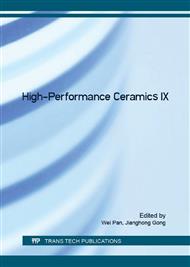p.633
p.639
p.644
p.648
p.652
p.658
p.664
p.670
p.675
Analysis on Low Cycle Fatigue Life and Fatigue Fracture Surface Morphology of TC25 Titanium Alloy
Abstract:
At room temperature, the low cycle fatigue tests for smooth specimens of TC25 titanium alloy under various stress ranges are operated at a CSS280I-20w Electro Hydraulic Servo Universal Testing Machine with a microscopic observation system, and the low cycle fatigue lifetimes are measured. Based upon the analysis of stress-strain hysteresis loop of low cycle fatigue of TC25 titanium alloy, a simplified Manson-Coffin formula is derived according to both the experimental characteristics and the stress-strain constitutive model, the fatigue lifetimes are plotted against stress ranges, and a stress-fatigue life curve for TC25 titanium alloy is obtained by the linear regression analysis method. Finally, the fracture surface morphologies of TC25 specimens are investigated using a JSM-6360 Scanning Electron Microscopy, and the fatigue fracture mechanisms of low cycle fatigue are studied. It shows that the plastic deformations are mainly formed at the accelerated fracture stage, and various shear lips can be observed on the fracture surfaces, which demonstrates that the shear stress results in the final rupture of TC25 titanium alloy. During the fracture of low cycle fatigue, the cleavage nucleation leads to the formation of fatigue crack initiation region, the fatigue crack growth exhibits a mixed transgranular and intergranular crack growth mode, and in the final rupture region, the fracture surface of low cycle fatigue of TC25 titanium alloy appears as a typical semi-brittle fracture mode.
Info:
Periodical:
Pages:
652-657
Citation:
Online since:
July 2016
Authors:
Price:
Сopyright:
© 2016 Trans Tech Publications Ltd. All Rights Reserved
Share:
Citation:


